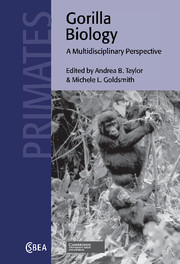Book contents
- Frontmatter
- Contents
- List of contributors
- Acknowledgments
- Epigraph
- Introduction: Gorilla biology: Multiple perspectives on variation within a genus
- Part 1 Gorilla taxonomy and comparative morphology
- Part 2 Molecular genetics
- Part 3 Behavioral ecology
- 11 An introductory perspective: Behavioral ecology of gorillas
- 12 Gorilla social relationships: A comparative overview
- 13 Within-group feeding competition and socioecological factors influencing social organization of gorillas in the Kahuzi-Biega National Park, Democratic Republic of Congo
- 14 Comparative behavioral ecology of a lowland and highland gorilla population: Where do Bwindi gorillas fit?
- 15 Are gorillas vacuum cleaners of the forest floor? The roles of body size, habitat, and food preferences on dietary flexibility and nutrition
- Part 4 Gorilla conservation
- Afterword
- Index
- References
13 - Within-group feeding competition and socioecological factors influencing social organization of gorillas in the Kahuzi-Biega National Park, Democratic Republic of Congo
Published online by Cambridge University Press: 11 August 2009
- Frontmatter
- Contents
- List of contributors
- Acknowledgments
- Epigraph
- Introduction: Gorilla biology: Multiple perspectives on variation within a genus
- Part 1 Gorilla taxonomy and comparative morphology
- Part 2 Molecular genetics
- Part 3 Behavioral ecology
- 11 An introductory perspective: Behavioral ecology of gorillas
- 12 Gorilla social relationships: A comparative overview
- 13 Within-group feeding competition and socioecological factors influencing social organization of gorillas in the Kahuzi-Biega National Park, Democratic Republic of Congo
- 14 Comparative behavioral ecology of a lowland and highland gorilla population: Where do Bwindi gorillas fit?
- 15 Are gorillas vacuum cleaners of the forest floor? The roles of body size, habitat, and food preferences on dietary flexibility and nutrition
- Part 4 Gorilla conservation
- Afterword
- Index
- References
Summary
Introduction
Competition over food and predation pressure plays an important role in shaping the social system of group-living primates (Wrangham, 1980, 1987; van Schaik, 1983, 1989; van Schaik and van Hooff, 1983; Terborgh and Janson, 1986; Dunbar, 1988). When a high risk of predation forces primates to live in cohesive groups, within-group scramble competition may stimulate females of folivorous primates to develop individualistic and egalitarian ranking systems (van Schaik, 1989; Barton et al., 1996; Sterck et al., 1997). When the risk of predation is low, females no longer form cohesive groups and tend to disperse to forage alone. Both food distribution and male mating strategy may influence female grouping patterns.
Gorillas have a folivorous diet and an individualistic ranking system (Fossey and Harcourt, 1977; Stewart and Harcourt, 1987). By contrast, chimpanzees have a fission–fusion social system based on individual foraging, and their party size varies with fruit abundance and availability (Goodall, 1968; Nishida, 1970; Wrangham, 1980). Male chimpanzees tend to associate with each other and to show territorial behavior against other groups of males (Goodall et al., 1979; Nishida et al., 1985). The various mating patterns (promiscuous, possessive or consort) adopted by males may influence the size and composition of temporary parties (Tutin, 1979; Goodall, 1986). These observations seem to support previous arguments that food distribution and male mating strategy effect social relationships among females (Wrangham, 1987; Dunbar, 1988; van Schaik, 1989).
- Type
- Chapter
- Information
- Gorilla BiologyA Multidisciplinary Perspective, pp. 328 - 357Publisher: Cambridge University PressPrint publication year: 2002
References
- 2
- Cited by

